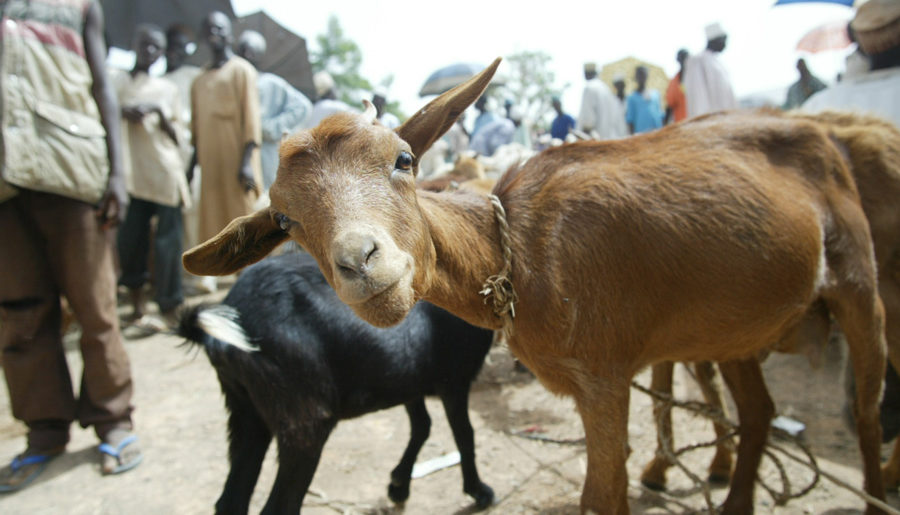Elida, a goat keeper and farmer from Lusaka, was struggling to make ends meet after her husband passed away. She started off by exchanging some crops for two goats in 2006. Now she has 48 of them! She sells goat meat, earning enough to pay for her children’s school fees, family health bills and, sometimes, even hires people to help her with harvesting her maize, cassava and beans.
Goat keeping helps Elida keep afloat, and that’s why it is particularly painful to see her goats suffering when they get sick. Last year she lost all the nine goat kids from her herd to a disease that caused diarrhea and bodily wounds in her animals. “It’s hard to get medication and veterinary advice around here,“ she says.
Goats are cheap, easy to transport and care for. For a long time, goats have been part of the local tradition and culture in Zambia, many people keep goats as ‘bank accounts’, slaughtering animals for special occasions, and sometimes selling animals to get cash.
However, people have generally not engaged in any significant trade of goats until recently. “There is a market for goats, but they aren’t seen as a business opportunity yet. And that’s one thing that needs to change in order to establish formalized market systems, ” says Sara Lysholm, a Ph.D. student at the Swedish University of Agricultural Sciences (SLU) and one of the authors of a policy brief “Factors enabling sustainable goat production in Zambia”.
But creating a supporting market structure for goats and goat meat is only one part of the challenge. The other aspect of goat value chain development is animal health.
Goats are considered to be hardy and resilient animals, but like Elida’s experience shows, they are susceptible to gastrointestinal and external parasites, which cause diarrhea, severe itching and, ultimately, affect animal’s productivity. Other health issues include foot rot and respiratory tract diseases.
All these health issues mostly occur due to poor management, but their roots lie in the shortage of resources and lack of investment. Many farmers do not have access to high-quality pastures, drugs or vaccinations. On the value chain level resource shortages also pose risks for goat-to-human disease transmission. For example, because there are few transportation options, people are bound to travel in close contact with their goats, which can lead to zoonotic outbreaks, like Q-fever and brucellosis.
It is good to remember that not all health interventions require expensive drugs or costly veterinary visits. For instance, constructing a good shelter that provides deep shade and protects animals from rain and wind. “Another strategy is to separate the newly purchased animals from the rest of the herd. Keeping the animals apart during the first weeks helps avoid disease exchange between groups. This could possibly be organized at a village-scale too,” says Jonas Johansson Wensman, a researcher at SLU who co-authored the recent brief about sustainable goat production, where you can find more advice about effective goat health and care.
These cheap and easy animal health strategies can go a long way, but they need to be implemented together with the efforts to establish a formalized market structure. Only then the much-needed poverty reduction and livelihood resilience benefits can be achieved.
According to Johansson Wensman, there have been discussions between Zambia and Saudi Arabia concerning the export of goat meat. Some sources say that Saudi Arabia would like to import 1 million goats a year. And Zambian smallholder farmers currently rear about 4 million goats. So, if this agreement comes into force, the demand for goats will go up, which would need a substantial increase in production, providing a massive opportunity for farmers and for the sector in general.
However, these talks have been going on for years and the agreement is yet to come into force. Johansson Wensman said, “One thing that came up during our discussions with the local stakeholders is that Zambian goat keeping sector can’t wait for government support. They have to tackle the issues with goat production on their own. There are many entrepreneurs in production, consultancy, farming and breeding who are trying to move things forward and develop the goat value chain.”
That’s the reality of goat production in Zambia. But, according to the researchers from SLU, developing a thriving goat production sector will require joint efforts among all the value chain actors. To coordinate cooperation and improve animal health, actors in the goat value chain need to have platforms where they can meet and discuss challenges, find common solutions and coordinate activities.
Many of the problems listed by stakeholders in the goat value chain are easily solved with access to finance, advisory support and resources, like access to medical supplies, grazing areas and water. It’s important that policymakers focus on solving these immediate problems which are likely to have a significant positive impact on animal health and production in Zambia as a whole.
This way, Elida and other goat keepers like her can continue growing their businesses with confidence and thrive together with their families and animals.
Reporting by David Falk, Communication Consultant, SIANI and Ekaterina Bessonova, Communications Officer, SIANI.
